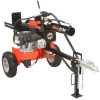Ariens 34-Ton Log Splitter Owners Manual - Page 7
No smoking, No sparks, No flames. ALWAYS, FOREIGN FLUID INJECTED INTO - log splitter
 |
View all Ariens 34-Ton Log Splitter manuals
Add to My Manuals
Save this manual to your list of manuals |
Page 7 highlights
DO NOT touch unit parts which might be hot from operation. Allow parts to cool before attempting to maintain, adjust or service. ALWAYS stop unit and allow moving parts to stop before leaving operator zone. Do not leave running unit unattended. DO NOT operate in the rain or in wet or damp locations. Assure that operator zone is free or debris and provides good footing. Know the weight of logs. Limit logs to those you can safely control and the unit can safely handle. Do not use log splitter for any purpose other than splitting logs. Do not move the unit up or down a hill by hand. Use a tow vehicle with suitable braking system. Use extra care when towing unit. DO NOT exceed 45 mph (72.4 kph). Safety chains MUST be attached to vehicle when towing unit. NEVER allow anyone to ride on the unit. NEVER transport cargo on the log splitter Check local, state and federal laws before towing. Any modifications required to meet these laws are the responsibility of the purchaser. ALWAYS stop engine, lock beam in horizontal position and close fuel shut-off valve when transporting unit. Keep unit free of leaves and other debris. DO NOT spray water to clean unit. ALWAYS keep protective structures, guards, and panels in good repair, in place and securely fastened. NEVER modify or remove safety devices. Stop and inspect equipment if there is an unusual vibration. Repair, if necessary, before restarting. Never make adjustments or repairs without first disconnecting the spark plug wire. Keep all hardware properly tightened. Maintain or replace safety and instruction labels, as necessary. Use only attachments or accessories designed for your unit. Check attachment components frequently. If worn or damaged, replace with manufacturer's recommended parts. This product is equipped with an internal combustion engine. DO NOT use on or near any unimproved, forest covered or brush covered land unless the exhaust system is equipped with a spark arrester meeting applicable local, state or federal laws. A spark arrester, if used, must be maintained in effective working order by the operator. DO NOT run engine in an enclosed area. Always provide good ventilation. Fumes from engine exhaust can cause injury or death. Fuel is highly flammable and its vapors are explosive. Handle with care. Use only an approved gasoline container with an appropriately sized dispensing spout. No smoking, No sparks, No flames. ALWAYS allow engine to cool before servicing. NEVER fill fuel tank when engine is running or hot from operation. NEVER fill or drain fuel tank indoors. Replace fuel cap securely and clean up spilled fuel. Properly remove fuel before tipping unit. Never fill fuel containers inside a vehicle or on a truck or trailer bed with a plastic liner. Always place containers on the ground away from your vehicle before filling. Keep the nozzle in contact with the rim of the fuel tank or container opening at all times until fueling is complete. Do not use a nozzle lockopen device. If fuel is spilled on clothing, change clothing immediately. NEVER store fuel inside where there is an open flame, such as a water heater. HYDRAULIC FLUID can result in severe burns. Fluid in hydraulic system can penetrate skin and result in serious injury or death. • Be sure to stop the engine and relieve hydraulic pressure before doing any work on hydraulic parts. • Keep body and hands away from pin holes or nozzles which expel hydraulic fluid when under pressure. Use paper or cardboard, not hands, to search for leaks. • Ensure all hydraulic fluid connections are tight and all hydraulic hoses and lines are in good condition before applying pressure to system. • FOREIGN FLUID INJECTED INTO BODY can result in gangrene. Fluid must be surgically removed within a few hours by a doctor familiar with this form of injury. • Do not adjust the pressure settings on the hydraulic pump or valve. GB - 7















